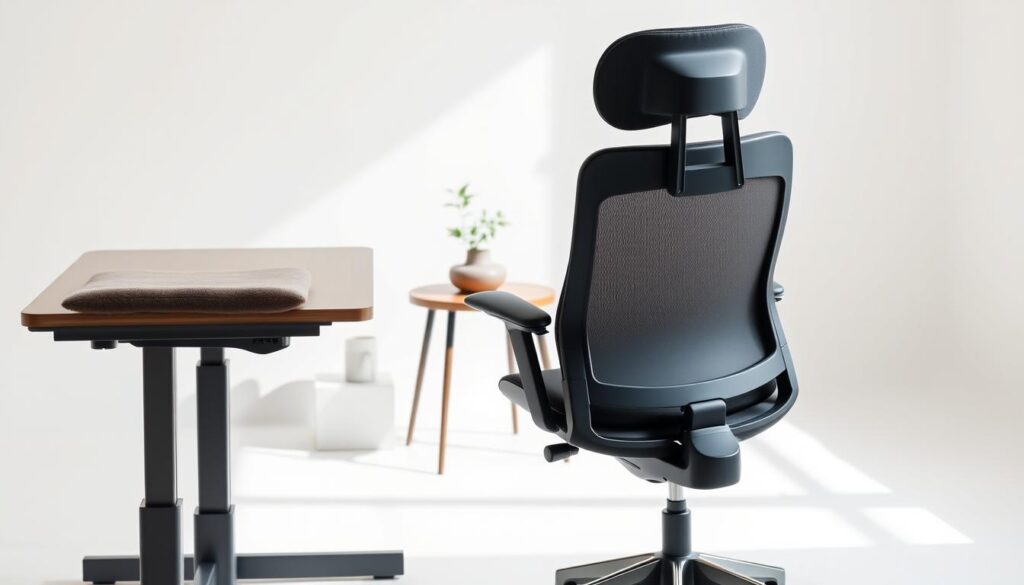Remote workers sit at desks for hours, making neck stretches vital. Stretching regularly keeps the neck healthy and eases discomfort from sitting too long. A daily neck stretch routine fights the bad effects of sitting, boosts flexibility, and lowers pain risks.
This guide offers key neck exercises for your workday. It helps you stay comfortable and productive all day.
The Importance of Stretching for Remote Workers
More people are working from home, and the fewer moves we make, the more our health can suffer. Sitting too long can cause serious health issues, like constant pain and problems moving around easily. Stretching regularly helps avoid these problems and makes us feel better overall.
Understanding the Risks of Sedentary Work
About 80% of workers in America feel discomfort from sitting all day at a desk. Sitting too much can lead to health problems from doing the same things over and over and sitting the wrong way. Moving around and stretching every day can help lessen these problems a lot.
The Impact of Poor Posture on Neck Health
Sitting the wrong way is bad for your neck. If you don’t sit properly, you can hurt your neck and feel pain for a long time. Keeping your neck straight is key. Doing simple stretches can help fix the bad effects of sitting poorly and keep your neck right.
Common Neck Issues Among Remote Workers
Remote work can lead to neck problems because of long hours in front of screens. Knowing the signs of neck pain helps catch issues early to ease discomfort. This part talks about neck pain signs and what causes the stiffness.
Identifying Symptoms of Neck Pain
Many remote workers feel different kinds of neck pain. You might notice:
- Sharp or dull aches in the neck area
- Stiffness limiting the range of motion
- Discomfort radiating to the shoulders and upper back
- Tightness or knots in neck muscles
Seeing these signs helps tackle the root causes of your neck pain.
The Causes of Stiffness and Discomfort
Various factors lead to neck stiffness and pain in remote workers. Staying in one pose too long, like slouching, is a main cause. Constant typing or mouse use makes it worse. Workspaces that don’t fit you right can also harm your posture. Stress adds to muscle tightness and tension.
Benefits of a Daily Neck Stretch Plan for Remote Workers
A daily neck stretch plan is a boon for remote workers. It boosts flexibility and movement range. This better movement is key due to the strains of sitting all day.
Enhancing Flexibility and Range of Motion
Doing neck stretches regularly makes you more flexible. It lets remote workers move more freely. This avoids stiffness from sitting too long and keeps neck pain at bay.
Boosting Productivity and Reducing Stress
Stretches can make you work better and feel less stressed. It’s shown that stretching can increase work output and mental health. Less stress improves mood and motivation, preventing burnout.
Guidelines for Effective Neck Stretching
Adding effective neck stretches to your daily plan is key for keeping your neck healthy. This is really important for people who work from home. To lessen the risks of sitting all day and bad posture, remember to sit up straight, breathe normally while stretching, and be gentle.
How to Properly Perform Neck Stretches
Follow these tips for the best results from neck stretches:
- Start each stretch softly to let your muscles ease into it.
- Keep the stretch for 15 to 30 seconds, making sure it feels good.
- Stand or sit straight to keep your spine in line.
- Let your shoulders stay loose and don’t slouch.
When and How Often to Stretch
It’s crucial to make a schedule for stretching. Experts suggest stretching every hour to help relieve neck tension. Doing these stretches three to five times during your work day will help make your neck more flexible and mobile over time.
Essential Neck Stretches for Relief
Adding neck stretches to your day can ease tension from sitting too long. Try seated neck rolls and forward and backward tilts. These moves boost blood flow and ease stiffness.
Seated Neck Rolls
To do seated neck rolls, sit with your feet on the floor. Lean your head towards one shoulder, roll it forward to the other shoulder, and back up. Do this for 30 seconds, breathing deeply. It makes your neck more flexible and feels great.
Neck Forward and Backward Tilts
For forward and backward tilts, sit and drop your chin to your chest for five seconds. Then, lift your head and look up for five seconds. Repeat a few times. These tilts lessen neck pain and are easy to do anywhere.
Integrating Stretches into Your Workday
Adding stretches to daily work helps those working from home a lot. It’s good to stretch throughout the day to feel better and boost wellbeing. By planning and setting reminders, you can make it a habit to stretch regularly.
Timely Reminders to Stretch
Using apps or timers can remind you to stretch. These reminders help you move and not just sit for too long. Try to stretch every hour to keep your body healthy all day.
Combining Movement with Task Changes
Connecting stretches with different tasks makes it easier to do during the day. For example, stand up when thinking or walk while on the phone. This helps make stretching a habit and can make you more productive by clearing your mind.
Daily Neck Stretch Plan for Remote Workers
For remote workers, setting up a daily neck stretch plan is key. It helps keep you comfortable and productive at work. By doing short, effective stretches, you can ease tension and feel better overall.
A Step-by-Step Routine for the Office
Here’s a simple routine that fits into your workday without big interruptions:
- Begin with gentle neck rolls to ease tension. Do this for about one minute.
- Continue with side bends. Spend about 15 seconds on each side to stretch.
- Add forward and backward tilts. Try to hold these for 10 seconds for the best stretch.
Quick Stretches to Do at Your Desk
You can do these stretches at your desk any time:
- Try seated neck rotations while you work. Look over each shoulder gently.
- Do shoulder shrugs to let go of tension. Lift your shoulders up and then relax them.
- Take a break for chin tucks. Pull your chin toward your chest and hold it there for a bit.
Complementary Exercises for Overall Wellness
Doing different exercises is key for staying healthy, especially if you sit a lot. Adding activities that move your whole body helps with neck stretches. This makes you more flexible and strong. Yoga and pilates, for example, help you stand up straighter, make your core strong, and keep you healthy. This is great for people who work from home and often have neck pain.
Incorporating Full-Body Movements
Moving your whole body is important to counteract sitting too much. These workouts don’t just help your neck. They work out many muscles all at once for a better exercise session. Some good workouts include:
- Burpees
- Squats
- Lunges
- Plank variations
These exercises improve blood flow and strengthen muscles. They are great alongside neck stretches.
The Role of Yoga and Pilates
Yoga and pilates are very helpful for people who work remotely. They improve how you stand, make you more flexible, and strengthen your middle. Yoga helps you calm down and focus. Pilates works on making your core muscles strong and keeping your spine straight. You can easily add them to your daily schedule for better health.
Tools and Accessories to Support Stretching
It’s crucial to make your workspace ergonomic if you work at a computer for long hours. Adjusting your workstation correctly can lessen neck and back pain, improving your health. Using furniture that supports you well is a major part of this.
Ergonomic Furniture and Workstation Adjustments
When arranging your workspace, remember these points:
- Your desk should be at a height where your elbows are bent at 90 degrees. This position helps you keep a good posture.
- Select chairs that have lumbar support to maintain a natural spine curve.
- Set your monitor level with your eyes to avoid craning your neck.
Ergonomic furniture choice is vital in avoiding discomfort from long work hours. Making regular workstation tweaks can also help make you more comfortable and productive.
Apps and Timers to Enhance Stretching Habits
Adding stretching apps to your routine is also important. It helps keep you healthy. For example, StretchClock can remind you to stretch or move regularly. These reminders are great for staying active during your day.
Using these tools can help keep your body healthy, making it easier to focus and reducing tiredness. A good ergonomic setup and useful apps make for a more efficient and balanced work-life for people who work remotely.

Conclusion
For remote workers who sit a lot, a daily neck stretch is vital. This article showed how stretching helps counteract the downsides of sitting too much. Doing these stretches fights off stiffness and boosts neck health.
Regular stretching improves your flexibility and how well you can move. This makes working from home more comfy and boosts productivity. Adding simple stretches to your day helps keep your neck healthy for a long time. Even a little change can greatly improve your neck’s health.
To do well while working remotely, you must move around, especially during work hours. Adding neck stretches to your daily routine helps ease discomfort. It also leads to a healthier, more balanced life.



